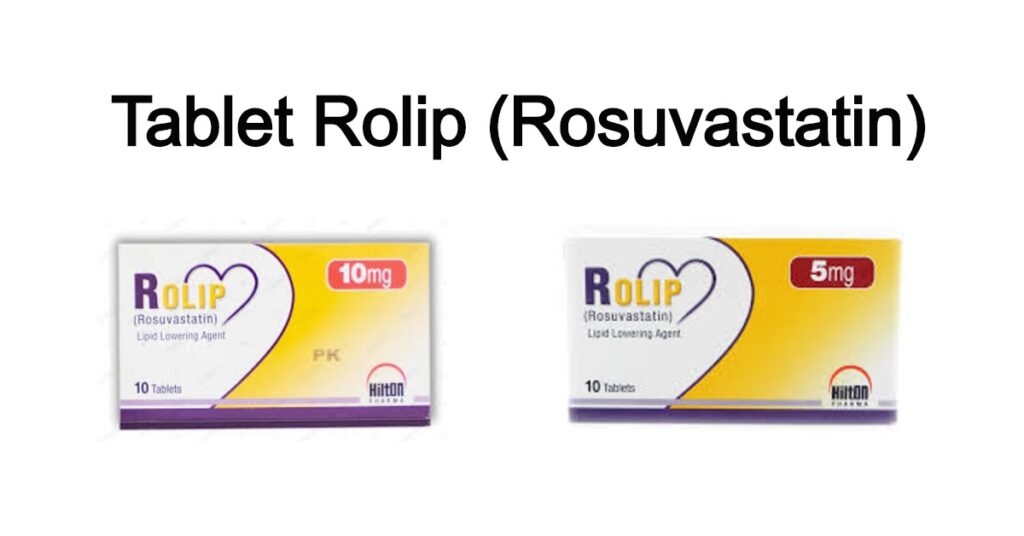Rolip (Rosuvastatin)
Tablets
Description
Rosuvastatin Calcium, a synthetic lipid-lowering agent, is an inhibitor of HMG-CoA reductase.
Composition
Rolip 5mg Tablets: Each film coated tablet contains Rosuvastatin (as Rosuvastatin calcium) ……… 5mg.
Rolip 10mg Tablets: Each film coated tablet contains Rosuvastatin (as Rosuvastatin calcium)…… 10mg.
Rolip 20mg Tablets: Each film coated tablet contains Rosuvastatin (as Rosuvastatin calcium) …… 20mg.
Pharmacology: Mode of action
Rolip (Rosuvastatin), a competitive selective inhibitor of HMG-CoA reductase (the rate-limiting enzyme that converts 3-hydroxy-3-methylglutaryl coenzyme A to mevalonate, a precursor of cholesterol), increases the number of hepatic LDL receptors thus increasing catabolism of LDL.It also prevents hepatic synthesis of VLDL. As a result, It decreases total cholesterol, LDL-C, ApoB, and nonHDL-C, and TG,and increases HDL-C
Indications and usage
Indications of Rosuvastatin Calcium Tablets are as follows: Elevated total-Cholesterol,LDL-C, ApoB, and nonHDL-C, and TG levels and to increase HDL-C in patients with primary hypercholesterolemia (heterozygous familial and nonfamilial) and mixed dyslipidemia (Fredrickson Type lla and Hb), as an adjunct to diet. • Elevated serum TG levels (Fredrickson Type IV), as an adjunct to diet. . Homozygous familial hypercholesterolemia as an adjunct to other lipid-lowering treatments (e.g., LDL apheresis) or if such treatments are unavailable.
Contraindications
: Rosuvastatin Calcium tablets are contraindicated in:
• Patients with a known hypersensitivity to any component of this product.
• Patients with active liver disease or with unexplained persistent elevations of serum transaminases.
• Pregnant women: Rosuvastatin should be administered to women of childbearing age only when such patients are highly unlikely to conceive and have been informed of the potential hazards. If the patient becomes pregnant while taking this drug, therapy should be discontinued immediately.
• Nursing mothers.
Side Effects
Rosuvastatin is generally well tolerated. Side effects reported are mild and transient. Frequent reports are myalgia, constipation, asthenia, abdominal pain, and nausea. Less frequent are UTI, Sinusitis, Flu syndrome. Pharyngitis, Headache, Dyspepsia, Nausea, Asthenia, Back Pain and Rhinitis.
Precautions
elevated transaminases /Abnormal Hepatic Function, Myopathy / Rhabdomyolysis, Carcinogenesis, Mutagenesis, Impairment of Fertility.
Pregnancy
There are no adequate and well-controlled studies of Rosuvastatin in pregnant women. Hence it is contraindicated in women who are or may become pregnant.
Nursing mothers
It is not known whether Rosuvastatin is excreted in human milk. Hence administration of Rosuvastatin in nursing mothers should be taken on the basis of risk against benefit.
Use in children
The safety and effectiveness in pediatric patients have not been established.
Use in old age
The efficacy of Rosuvastatin in patients • 65 years of age is comparable to the efficacy observed in the nonelderly.
Overdose
There is no specific treatment in the event or overdose. In the event of overdose the patient should be treated symptomatically and supportive measures instituted as required like maintenance of airways, monitoring of vital signs etc. Hemodialysis does not significantly enhance clearance of Rosuvastatin.
Drug interactions
Co-administration of Rosuvastatin and cyclosporine causes no significant changes in cyclosporine plasma concentrations. However, Cmax and AUC of Rosuvastatin increase 11 and 7 times, respectively.These increases are clinically insignificant. Rosuvastatin does not change warfarin plasma concentrations but increases the International Normalized Ratio (INR). Administration of Ketoconazole,Itraconazole, Fluconazole, Erythromycin. Gemfibrozil, Digoxin, and Fenofibrate do alter Cmax and AUC but these changes are not significant clinically. Co-administered Rosuvastatin increases the plasma concentrations of ethinyl estradiol and norgestrel by 26% and 34%, respectively.
Co-administration of an antacid (aluminum and magnesium hydroxide combination) reduces plasma concentrations of Rosuvastatin by 54%. However, when given 2 hours after Rosuvastatin, it causes no clinically significant changes in plasma concentrations of Rosuvastatin.
Dosage and administration
A standard cholesterol-lowering diet should be started before starting Rosuvastatin and continued during treatment.
Rosuvastatin can be administered as a single dose irrespective of time and food. Dosage of Rosuvastatin should be adjusted as per the following table:
| Rolip dose | |
| In Heterozygous Familial and Nonfamilial Hypercholesterolemia and Mixed Dyslipidemia (Fredrickson Type lla and Ilb)* | |
| For patients requiring less aggressive LDL-C reductions or who have predisposing factors for myopathy, | 5-10 mg once daily |
| For patients with marked hypercholesterolemia (LDL-C> 190 mg/dl) and aggressive lipid targets | 20 mg once daily |
| For the patients who do not achieve the target LDL-C with ROSUVASTATIN 20mg | 40 mg once daily |
| In Homozygous Familial Hypercholesterolemia ** | |
| Starting dose | 20 mg once daily |
| Maximum dose | 40 mg once daily |
| Combined with other drugs | |
| Combined with Cyclosporine | 5 mg once daily |
| Combined with Gemfibrozil | 10 mg once daily |
| In Renal Dysfunction*** | |
| Severe | 5-10 mg once daily |

